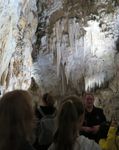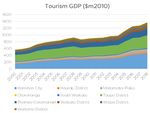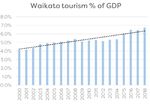On tour in the Waikato - Te Waka
←
→
Page content transcription
If your browser does not render page correctly, please read the page content below
Quarterly Economic
Update Q2 : 2019
On tour in the Waikato Blair Keenan
PRINCIPAL ECONOMIST,
From the Coromandel to King Country; WAIKATO REGIONAL
Port Waikato to the pathways of COUNCIL & ECONOMIC
Pureora; from Hobbiton to Hamilton ADVISOR TO TE WAKA
– and many places in between, the
Waikato region is full of potential
places to go and things to see and do. Blair Keenan has an
undergraduate degree
Not surprising, then, that in its latest from the University of
Shaping our slice of heaven report, Otago. Keenan worked at
Deloitte suggests that the tourism ANZ as a macro-economist
industry has the potential to provide as and industry analyst for
much additional economic benefit to five years before heading
the region over the next 20 years ($1.4 overseas as a researcher
billion) as its other three ‘industries of for Japan’s External
opportunity’ combined. At the same Trade Organisation in
time, tourism is increasingly coming the UK. While in the
into focus at a national level, with new UK, he also received his
strategies launched by both central Master’s degree in applied
government and Tourism Industry environmental economics
Aotearoa in May. Waitomo Caves from the University of
London and was an
The Waikato region has three very economist at the National
distinct visitor strategies for Hamilton Farmers Union of England
& Waikato Tourism, Destination and Wales.
Coromandel and Destination Great Lake
Taupō. Back in New Zealand, he
held several policy roles
In 2016 Hamilton & Waikato Tourism at Landcare Research,
adopted the Regional Tourism Department of Internal
Opportunities Plan to lift the value of Affairs and Housing New
tourism for the region. The growth and Zealand before his current
opportunities are covered in a summary role as principal economist
document of the plan. at Waikato Regional
Council. He also continues
So what does the foundation of this to collaborate on projects
impressive opportunity look like? What with the University of
is the state of play with Waikato tourism Waikato, CRIs, central and
now? And what needs to be done to local government, and a
achieve the impressive opportunities variety of industry groups.
foreseen by Deloitte?
Little Bay Coromandel Peninsula
PAGE 1
www.tewaka.nzQuarterly Economic Update
Q2 : 2019
Figure 1
The biggest spenders
amongst tourists were
from Europe, Australia,
Asia and America
According to the Ministry of Business, Innovation and
Employment (MBIE), tourism spending in the Waikato
reached $2.7 billion in the last year, with three-quarters ($2
billion) coming from domestic tourists, and the remainder
Source: Infometrics
($700 million) from international visitors. Around half of
that spending comes from Auckland, Bay of Plenty, or from
within the Waikato itself. The biggest spenders amongst Figure 2
international tourists in the Waikato were from Europe (nine
percent of total spending), Australia and Asia (six percent
respectively) and the Americas (five percent).
Tourism has been steadily growing in importance in the
Waikato in recent times. From around four percent of
regional Gross Domestic Product (GDP) in 2000, and after
catching its breath for a few years following the global
financial crisis, the tourism sector now makes up nearly
seven percent of GDP.
While Waikato’s tourism offering is spread across the region,
the value added is centred around two areas: Hamilton City
and Taupō District, which together make up 60 percent
of the regional total. Adding in the Thames-Coromandel
District, these three districts make up three-quarters of
the regions tourism industry. However, the fastest growing
district for tourism has been the home of Hobbiton, the
Matamata-Piako District where value-added has increased
Figure 3
by 160 percent since 2010.
The growth in visitor numbers also shows up in occupancy
rates for accommodation, with especially large increases
in Hamilton, Matamata-Piako and South Waikato. In
the case of Hamilton, average occupancy rates are now
amongst the highest in the country, at 66.5 percent, and
when large events roll into town (such as Fieldays, the
HSBC World Rugby Sevens series, or the conference of
the Native American and Indigenous Studies Association
later this month), there is little or no room at the inn. With
the prospect of further growth in demand, the case for
investment in new capacity in and around Hamilton is surely
worth a closer look.
PAGE 2
www.tewaka.nzQuarterly Economic Update
Q2 : 2019
Figure 4
Tourism dollars employ
21,000 people in the
Waikato region
But the tourism industry is much more than accommodation
services. It covers a proportion of retail trade. Many
businesses in retailing, restaurants and cafes, transport,
tourist sites and other activities have an important part of
their customer base that derives from visitors. Across these
various sectors, tourism dollars employ 21,000 people in the
Waikato region.
The importance of the tourism sector to the regional cost? What else might we have done with those resources?
economy is clear – and growing. But what is required to Are we confident that there were not other, higher value,
achieve the sort of growth that Deloitte envisages? uses for our capital? This question is particularly pertinent
because jobs in the tourism sector have historically had
One point to consider: If we put our efforts and resources relatively low levels of productivity. If we add jobs in this
into growing the tourism industry, what is the opportunity sector, do we limit the value that is being created?
Waireinga/Bridal Veil Falls, Raglan
PAGE 3
www.tewaka.nzQuarterly Economic Update
Q2 : 2019
There are a couple of reasons why
we might be cautiously optimistic
Tourism products in the Waikato
here. Firstly because this issue is are critically dependent on the
recognised, and explicitly addressed
in industry strategies. For example, region’s natural capital
improving tourism sector productivity
is an explicit outcome sought by
the government’s strategy. The TIA
strategy includes specific actions that This means the industry has a and environmentally based eco-
address the productivity question, vested interest in the health of the tourism. Crucially, it involves iwi,
including better measurement environment, and is not engaging in Regional Tourism Organisations,
of productivity, targeting value activities that would damage its own local government, businesses and
rather than volume and prioritising (natural) capital base and hence, its others and aims to make sure all are
infrastructure investment. Of course, productivity. paddling the waka in unison.
the devil is in the detail, and the
challenge for the sector will be to Te Waka’s Regional Economic As it this part of the programme
make sure that this focus continues to Development Programme for 2018- progresses, it will be important to
translate into tangible and effective 22 (which you can check out here) keep an eye on the goal of improving
actions. provides a good start to efforts productivity in the way we use the
to achieve the region’s tourism region’s resources, and by ensuring
Another point to note is that a large potential. Amongst other things, it that the foundations of the sector –
proportion of tourism products in pulls together a significant bundle the Waikato region’s environment,
the Waikato are critically dependent of actions and projects focusing people and infrastructure – are in
on the region’s natural capital. on creative and cultural industries good shape. •
8-031019
Huka Falls, Taupō Balloons over Waikato, Hamilton
PAGE 4
www.tewaka.nzYou can also read



























































